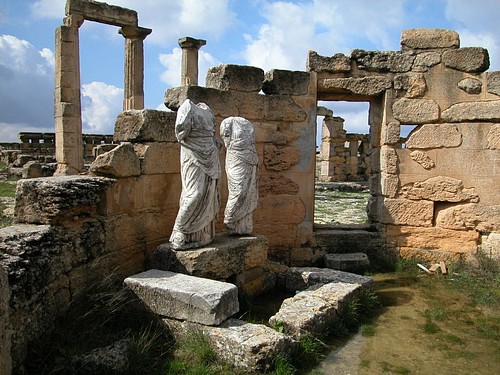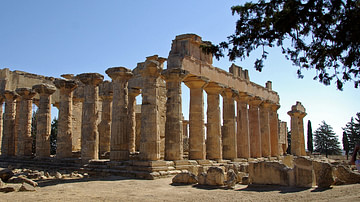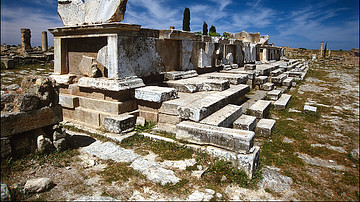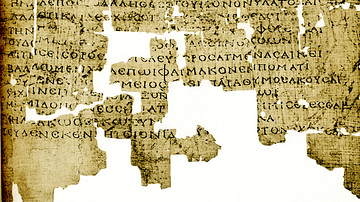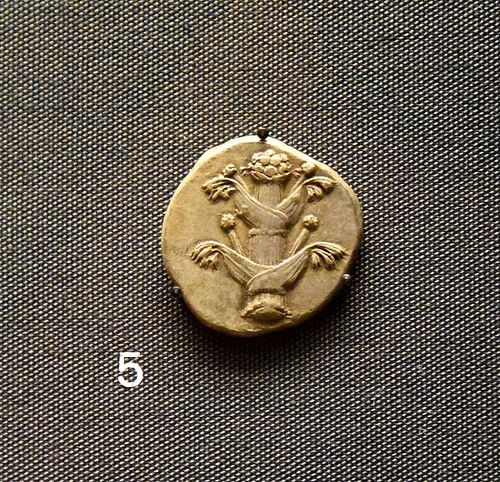
Silphium (also known as laser) was an uncultivated plant that grew in Cyrene, North Africa (modern Shahhat, Libya) and became the cash crop of the region of Cyrenaica between c. 631 BCE and the 1st century CE when, according to Pliny the Elder, it had become extinct. Its disappearance is considered the first recorded species extinction in history.
The plant grew wild in a narrow strip of land in Cyrenaica (the region surrounding Cyrene) thought to have been approximately 201 kilometers (125 mi) by 40 kilometers (35 mi) in the area around the city of Euesperides (Gorvett, 2). According to Strabo (l. c. 64 BCE to c. 24 CE), the plant was nearly destroyed by a barbarian invasion – though he does not identify the invaders or give a date – but modern scholars, following the 1st century CE report of Pliny the Elder (l. 23-79 CE), believe its extinction was due to overharvesting and overgrazing.
According to Pliny, "within the memory of the present generation, a single stalk is all that has ever been found there, and that was sent as a curiosity to the Emperor Nero" (Natural History, 19:15). In its time, however, silphium was so plentiful it became the primary export of Cyrene for centuries and was so valuable its sale transformed the city from a small colony on the coast of Libya to one of the wealthiest in the Mediterranean.
The plant was used as a seasoning, an aromatic, an antiseptic, analgesic, and was a popular form of birth control. Silphium, in fact, seems to have been regarded as a cure-all and, according to Pliny, was sold for its weight in silver. Pliny emphasizes silphium's value in noting that, in addition to gold and silver, Julius Caesar withdrew 1500 pounds of the plant's resin from the public treasury to help pay for his civil war with Pompey the Great.
The most complete description of the plant comes from Theophrastus (l. c. 371 to c. 287 BCE), the Father of Botany and friend of Aristotle (l. 384-322 BCE), in his Enquiry into Plants, chapters 3.1.7, 3.2.1 and 6.3.2-6.3.5 where it is referenced as silphium, the Greek name for the plant. The Romans knew it as laser and its resin as laserpicium, as it appears in the Roman cookbook of the 5th-century CE, the Apicius. It may have been a species of the genus Ferula, but this is unclear.
Although the plant was carefully described by Theophrastus and its image appeared on the coins of Cyrene, it has not been positively identified. It is thought to have been comparable to fennel and may have been a hybrid. The plant only flourished in the wild and could not be cultivated, so once the resources of its natural habitat were depleted, it disappeared. Modern claims to have discovered silphium still growing in various regions around the world (such as recent assertions regarding a similar plant in Turkey) are regularly challenged and debunked, although scholars continue to hope it might still be growing somewhere in the region of ancient Cyrenaica.
Cyrene's Founding & Expansion
Cyrene was established as a colony of the Greek island of Thera (modern Santorini) in 631 BCE. According to legend, the Therans were told by the Oracle at Delphi to send an expedition to colonize the coastal region of Libya to resolve their problem of overpopulation. The expedition first landed at the island of Platea and then the region on the mainland known as Asilis (also given as Aziris), and, according to Herodotus (l. c. 484-425/413 BCE), this is where silphium grew wild and was used by the indigenous tribes of the surrounding area:
The next tribe are the Giligamae, whose territory extends west as far as an island called Aphrodisias. Platea (the island where the Cyreneans settled) lies about half-way along the stretch of coastline occupied by this tribe, and on the mainland is a bay called Menelaus, and also Asiris, where the Cyreneans lived. Silphium starts growing here; it grows from Platea to the mouth of the Gulf of Syrtis.
(Book IV. 169)
Herodotus also notes how "there are weasels living in the silphium" and the area was known for its abundant wildlife (Book IV. 192) suggesting it was uncultivated land (which agrees with Theophrastus' conclusions).
The city developed under the first three kings of the Battiad Dynasty:
- Battus I – r. c. 631 to c. 599 BCE
- Arcesilas I – r. c. 599 to c. 583 BCE
- Battus II (the Prosperous) – r. c. 583 to c. 560 BCE
Trade was established under Battus I, developed under Arcesilas I, and the economy was booming by the time of Battus II with silphium as the major crop. The land, overall, was so fertile the harvest season lasted eight months, producing grain, vegetables, and other cultivated crops. Herodotus comments:
The land around Cyrene, which is the highest area in the part of Libya that is inhabited by the nomads, has, incredibly, three harvest-times. First the coastal crops ripen and become ready for cutting and gathering; once they have been collected, the crops inland from the coast, in the area known as the hills, become ripe enough to collect; and after this second crop has been harvested, the grain in the highest part of the country ripens and matures. As a result, just when the first crop has been consumed as food and drink, the final crop arrives. In fact, harvesting occupies the people of Cyrene for eight months of the year.
(Book IV. 199)
These crops, along with the uncultivated silphium which the indigenous people had introduced to the Cyreneans, became the city's main source of revenue, encouraging urban development and, eventually, the establishment of the Pentapolis ("five cities") of Cyrenaica:
- Cyrene (modern Shahhat)
- Barca (modern Al-Marj)
- Euesperides (modern Benghazi)
- Apollonia (the port of Cyrene, modern Marsa Susah)
- Taucheira (modern Tukrah)
Battus II invited Greeks from the Peloponnese, Crete, and other areas to join the colony, increasing the population and the workforce that harvested silphium. By the time of the fourth king of the Battiad Dynasty, Arcesilas II (the Harsh, r. c. 560 to c. 550 BCE), Cyrene and the other cities were fabulously wealthy.
Appearance, Harvesting, & Uses
Pliny the Elder provides the origin of silphium in a passage from his Natural History:
We find it stated by the most trustworthy Greek writers that this plant first made its appearance in the vicinity of the gardens of the Hesperides and the Greater Syrtis, immediately after the earth had been soaked on a sudden by a shower as black as pitch. This took place seven years before the foundation of the city of Cyrene, and in the year of Rome 143. The virtues of this remarkable fall of rain extended, it is said, over no less than four thousand stadia of the African territory; and upon this soil laserpicium began universally to grow, a plant that is in general wild and stubborn, and which, if attempted to be cultivated, will leave the spot where it has been sown quite desolate and barren.
(19:15)
Silphium seems to have only grown in the region of Cyrenaica, resisted cultivation, and confined itself to the undeveloped areas around Euesperides. Theophrastus describes the plant:
The silphium has a great deal of thick root; its stalk is like ferula in size, and is nearly as thick; the leaf, which they call inaspeton, is like celery; it has a broad fruit, which is leaf-like, as it were, and is called the phyllon. The stalk lasts only a year, like that of ferula…the root has a black bark, which is stripped off…The plant is found over a wide tract of Libya, for a distance, they say, of more than four thousand furlongs, but it is most abundant near the Syrtis, starting from the Euesperides islands. It is a peculiarity of it that it avoids cultivated ground, and, as the land is brought under cultivation and tamed, it retires, plainly showing that it needs no tendance, but is a wild thing.
(6.3.2)
He also notes that the leaf was a golden color and how harvesting the plant was strictly controlled:
They have regulations, like those used in the mines, for cutting the root, in accordance with which they fix carefully the proper amount to be cut, having regard to previous cuttings and the supply of the plant. For it is not allowed to cut it wrong nor to cut more than the appointed amount; for, if the juice is kept and not used, it goes bad and decays. When they are conveying it to Piraeus [the port of Athens], they deal with it thus: having put it in vessels and mixed meal with it, they shake it for a considerable time, and from this process it gets its color, and this treatment makes it thenceforward keep without decaying.
(6.3.2)
The uses of the plant seem to have been unlimited. It flavored food but was also used to make perfume. The roots were eaten fresh, sometimes dipped in vinegar, but were also roasted or boiled and produced an aromatic juice. It was a contraceptive, a diuretic, an analgesic, and was said to not only fatten sheep that grazed on it but also "make their flesh wonderfully delicious" (Theophrastus, 6.3.2).
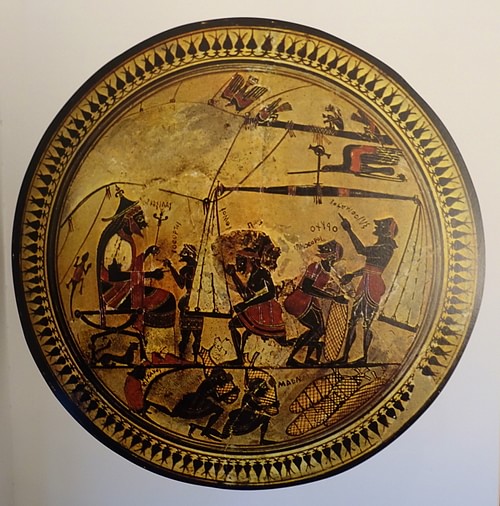
Once it was understood that silphium enriched the taste and quality of mutton, sheep (and other livestock) were driven to the fields to graze on the plant:
They used to feed the cattle there upon it; at first it purged them, but afterwards they would grow fat, the flesh being improved in flavor in a most surprising degree. After the fall of the leaf, the people were in the habit of eating the stalk, either roasted or boiled; from the drastic effects of this diet, the body was purged for the first forty days, all vicious humors being effectually removed.
(Pliny, 19:15)
Relief from "vicious humors" which made one ill was only one of the benefits of silphium, however, as it could also be applied to heal dog bites, cure coughs, relieve strained muscles, settle indigestion, remove warts, and serve as a contraceptive.
Contraceptive & Heart Symbol
Silphium's reputation as a contraceptive (or, possibly, abortifacient) comes not from Pliny or Theophrastus but from other Greek and Roman writers including the poet Catullus (l. 84-54 BCE), the travel writer Pausanias (l. 110-180 CE), and the physicians Dioscorides (the Father of Pharmacognosy, l. 1st century CE) and Soranus of Ephesus (l. 1st century CE), among others. Soranus, in his Gynecology, suggests taking silphium the size of a chickpea dissolved in water monthly to prevent conception. Pausanias relates how the Dioscuri (Castor and Pollux) visited the home of a maiden and, the next day, "this maiden and all her girlish apparel had disappeared, and in the room were found images of the Dioscuri, a table, and silphium upon it" (3.16), suggesting it had been used as a contraceptive. Catullus' reference is vaguer (in Carmen 7) but still suggestive of an association between silphium and sexual intercourse.
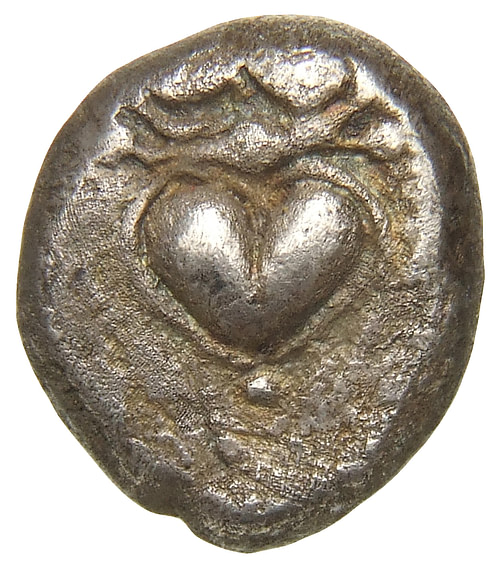
Contrary to the many claims in videos and internet articles, silphium does not seem to have been the most effective and sought-after contraceptive as it is referenced by Dioscorides and Soranus along with many others (including date palm, figs, myrrh, root of panax, pennyroyal, pomegranate peel, rue) without distinction. The popularity of silphium seems to have been due to its reputation as a cure-all and as an aromatic far more than anything having to do with sexual relations.
The claim that the silphium seed, as depicted on the coins of Cyrene, inspired the popular heart symbol of the modern era is also incorrect. This argument depends on the association of silphium with sex and romantic pursuits, but, as silphium is not given any elevated status in this regard by ancient writers, that link does not seem to have existed. The YouTube channel Cogito Edu further debunks this claim in noting how the image on the coins (appearing between c. 500-275 BCE) would not have been known by the Romans (from whom, according to the claim, the heart symbol derived) who only took control of the region in 96 BCE and would have been unlikely to concern themselves with ancient foreign currency.
Cyrene's Decline
Cyrene began to decline under the reign of Arcesilas II (the Harsh) whose arguments with his brothers resulted in a civil war that cost Cyrene 7,000 casualties in its conflict with neighboring Barca. The city's economy was revived under Battus III (the Lame, r. c. 550 to c. 530 BCE), who instituted a democracy and improved the economy, but Cyrene's fortunes reversed under his successor Arcesilas III (r. c. 530 to c. 514 BCE), who overthrew the democracy with the help of his mother and re-established the monarchy until his assassination c. 514 BCE.
He was succeeded by Battus IV (the Fair, r. c. 514 to c. 470 BCE), who was then succeeded by Arcesilas IV (r. c. 470 to c. 440 BCE), champion of the Pythian and Olympic Games in chariot racing, whose assassination ended the Battiad Dynasty. Cyrenaica was taken by Alexander the Great c. 332/331 BCE and then, after his death, by his general Ptolemy I Soter (r. 323-282 BCE), founder of the Ptolemaic Dynasty of Egypt. While Ptolemy I fought with the other generals formerly under Alexander in the Wars of the Diadochi, a lesser commander named Thibron invaded Cyrene in 322 BCE and was defeated (and later executed) by Ptolemy I's general Ophellas (l. c. 350-308 BCE), who then became governor of Cyrene.
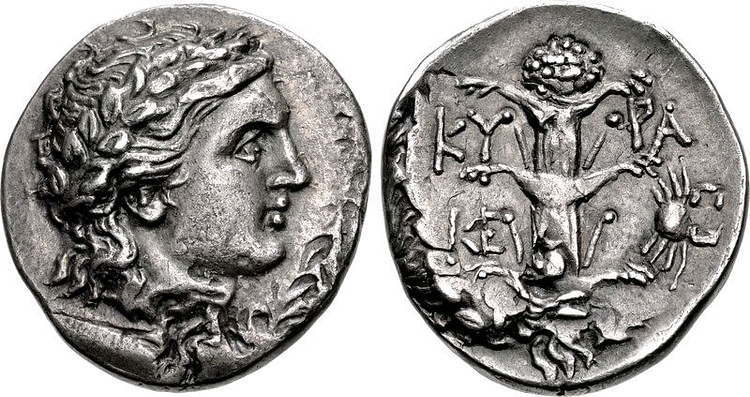
The Foundation Decree of Cyrene is thought to have been issued at this time (c. 322 BCE), to encourage citizens of Thera to migrate to Cyrene to restore the workforce – perhaps associated with the harvest of silphium – after the losses caused by the conflict. The Decree promises equal rights to any citizen of Thera who chose to settle in Cyrene, and this offer may have been inspired by the need to replace silphium workers who had become casualties of war.
Conclusion
Cyrenaica was controlled by the Ptolemaic Dynasty until Ptolemy Apion willed it to Rome in 96 BCE. The region flourished initially, but by the 1st century CE, overharvesting and overgrazing had adversely affected the silphium crop. The Roman historian Arrian (l. c. 86 to c. 160 CE) writes:
Sheep are very fond of silphium. If a sheep smells the plant from afar, it runs to it and feeds on the flower; they also dig with their hooves to unearth the roots, which are eaten in the same way. For this reason, in Cyrene, they usually graze their flocks, as far as possible, outside the places where silphium plants grow; others even enclose the plants with a fence so that, if the sheep manage to get close, they cannot get inside the enclosure.
(Anabasis of Alexander, 28)
According to Pliny the Elder, however, this practice was ignored by many of the tenant farmers of Cyrenaica who needed to turn a profit for their absentee landlords through trade in silphium-fattened sheep:
For these many years past, [silphium] has not been found in Cyrenaica, as the farmers of the revenue who hold the lands there on lease have a notion that it is more profitable to depasture flocks of sheep upon them. Within the memory of the present generation, a single stalk is all that has ever been found there, and that was sent as a curiosity to the Emperor Nero.
(19:15)
Pliny mentions substitutes for silphium from Persia, Media, and Armenia but notes their inferior quality to the plant of Cyrene. As overgrazing and overharvesting depleted the silphium of Cyrenaica, its scarcity drove up demand and made it even more valuable. It is believed that the tenant farmers, in trying to meet that demand, ignored the careful regulations for harvesting as described by Theophrastus, destroying the roots, and eventually driving the plant to extinction.
